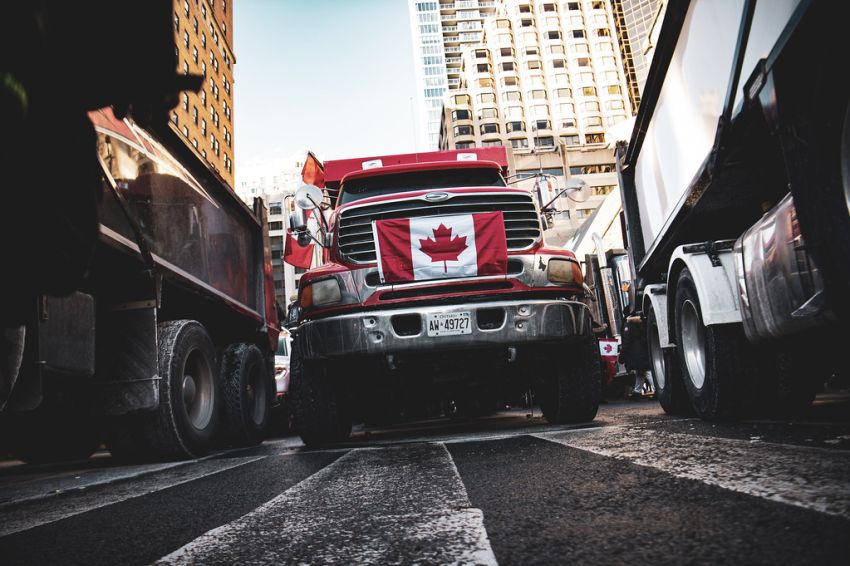
The far-right Freedom Convoy that rolled into Ottawa at the end of January, and has been occupying the capital ever since, wants Liberal Prime Minister Justin Trudeau to resign — or be locked up as a “traitor”. Instead, opposition Conservative Party leader and convoy supporter Erin O’Toole has fallen.
In a significant sign of the rightward shift taking place in Canadian politics, O’Toole was ousted on February 2 by his own party caucus, with fellow MPs viewing him as not being sufficiently far-right or socially conservative. The rightward shift was reinforced by the Conservatives’ selection of deputy leader and social conservative Candice Bergen to replace O’Toole as interim leader.
Echoing comments made by former United States President Donald Trump, Bergen suggested to colleagues that there are “good people on both sides” of the Freedom Convoy.
The Freedom Convoy is a far-right mobilisation organised by people with longstanding links to organisations, including neo-fascist groups, that espouse anti-immigrant, Islamophobic and white supremacist views. First presented as an expression of opposition to vaccine mandates, the convoy has shift its messaging to one of freedom and against perceived political “traitors” in government.
The expectation is that a right-wing populist or social conservative will take the reigns of the party after leadership elections expected to be held later this year.
Within the Conservatives, public support for the Freedom Convoy has become something of a litmus test. A range of high profile party figures, in addition to Bergen, have expressed support for the convoy, including several MPs and Senator Denise Batters, who has spent time with convoy participants.
In the 2021 election, the Conservatives won 119 seats in parliament. This makes them the official opposition to the Liberal Party, which with 159 seats could only form a minority government. However, the Conservatives won more votes (5,747,410 or 33.70%) than the Liberals (5,556,629 or 32.60%).
Concerningly, far-right parties achieved important gains.
The xenophobic People’s Party of Canada won more than 840,000 votes (5%). The Maverick Party, a Western Canada-based party that styles itself after the Brexit Party, and which has played a role in organising the Freedom Convoy, polled 35,278 votes. The Christian Heritage Party also garnered 9041 votes.
These compare with the tiny votes managed by the Marxist-Leninist Party (4856) and the Communist Party (4742).
The next federal election campaign will almost certainly be one in which positions and policies that might have been viewed as unacceptable or marginal will now be centre stage. Such an election could come sooner than expected, given Trudeau’s minority government could topple at any time.
Meanwhile, the convoy movement has spread across Canada, with actions occurring in Vancouver, Winnipeg, Toronto, Quebec City, Halifax and other cities.
Convoys have engaged in acts causing significant economic disruption. A blockade of the Ambassador Bridge between Windsor and the US city of Detroit began on February 7. This route hosts the largest flow of commercial traffic between Canada and the US. About 8000 transport trucks and $300 million worth of goods cross the Ambassador Bridge daily.
Two days later, a barricade of trucks in Sarnia, Ontario, began blocking traffic on the Blue Water Bridge, an alternate route that spans to Port Huron, US, while protests continue to interrupt a third US/Canada border crossing between Alberta and Montana.
The convoy has also inspired similar far-right protests in other countries. Convoy actions have been planned across the United States and all 27 European Union countries, with preparations for convoys to descend on Brussels on February 14. The Canadian convoy provided inspiration for the “Convoy to Canberra” in Australia.
The convoy movement, and the rise of far-right forces more generally, poses a real challenge to the left in Canada. In Toronto, the convoy was met with large counter-protests in support of healthcare workers, while in Vancouver, mini-bike blockades quickly organised over Reddit stopped the convoy before it could reach downtown hospitals.
These are laudable immediate responses and the people who undertook them should be thanked for their courage in action. But effectively opposing far-right forces will require more durable organising rooted in working-class communities.
It will require building infrastructures of resistance that can provide mutual aid and community self-defence, while showing real world alternatives for working-class people rightfully angry about the intensification of suffering under COVID-19 conditions.